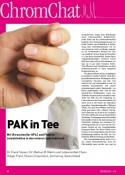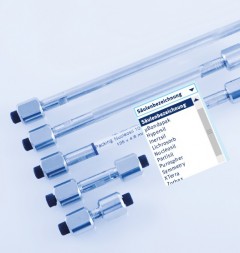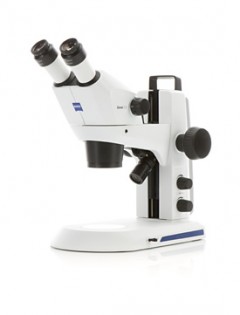|
L&M-4-2010
>
PAH in Tea
PAH in TeaUltra-fast HPLC und fluorescence detection at trace levelsA Polycyclic aromatic hydrocarbons (PAHs) contamination is normally associated with the crude oil refining industry or combustion processes using coal, fuel oil or petrol. The environmental catastrophe currently taking place in the Gulf of Mexico is a depressing example of an unimaginable contamination of the biosphere with, among other things, these toxic substances. Apart from these headline-laden reports, PAHs unfortunately also lurk in many foodstuffs where one would never expect them. Many plants, including crop plants, accumulate hydrocarbons in their lipophilic compartments. After water, tea is the most widely consumed drink worldwide. Thanks to their health promoting effects, the different varieties of tea have the reputation of being far more than just a stimulant. They contain antioxidants and other pharmacologically active ingredients which are considered to aid the body’s wellness. However, tea leaves accumulate toxic substances such as PAHs from their environment. The extent of this is affected by the different processing steps of the various varieties: For example, green tea is dried directly after withering and rolling, while oolong and black teas undergo taste refinement through high humidity oxidation. Drying processes over fossil fuels promote the accumulation of toxic substances during the individual processing stages [1], so that the enjoyment of tea can rapidly emerge as a health risk. To guard against this danger, a sensitive and robust method of identification for PAHs is essential in order for the risk to be reliably assessed. Foodstuff regulators face a real challenge, as PAH analysis must be precise and carried out in the lower ppb-range. Both GC and HPLC are possibilities for the analysis, with both methods showing advantages and dis advantages. Specialized PAH columns for HPLC analysis can cope well with separation problems, but quantification in the available concentration ranges is chalenging and requires high sen-sitivity detection techniques such as fluorescence detection. The fluorescent nature of the PAHs requires individual settings for almost any analyte. This is done by physically switching the excitation and emission monochromators be-tween the analyte bands. Classical liquid chromatographic methods were considered slow in the analysis of complex mixtures, but this perception has faded due to modern ultrahigh resolution HPLC or UHPLC methods, which can achieve analysis times of much less than 10 minutes, even for challenging applications. Up until now there have been two significant obstacles in PAH analysis: on the one hand there was a lack of UHPLC-capable separating columns with a selectivity suitable for PAHs; while on the other hand the switching times of the fluorescence detectors (FLD) could not keep pace with the rapid separation. In the past, marginally resolved and narrow analyte bands with dif-ferent wavelength setting requirements could not be de-tected by fluorescence. The monochromator drives were not designed for both switching speed and precision and the wavelength changes were done sequentially. The total switching time was a summation of both wavelength switching times, the sensitivity change and the delay caused by the detector response time. These problems are now resolved, have now be solved fully, as the methodological example presented here shows. This was carried out with the UHPLC-compatible Dionex UltiMate Standard 3000 System, equipped with the FLD-3100 detector and a Nucleodur C18 PAH separation column from MACHEREY-NAGEL GmbH & Co. KG. With a system pressure up to 620 bar and a FLD data rate up to 100 Hz, these columns can be operated at high linear velocity, achieving baseline resolution of 16 EPA PAHs in less than 3 minutes [2]. Figure 1 shows that the FLD wavelength switching is finished in record time well below one second. With the FLD-3400RS module variant, even additional switching of the filter on the emission side is possible, which leads to further optimisa-tion of the trace detection capacity. Figure 2 shows the separation from 17 active fluorescent PAHs in 5.5 minutes, notable for the excellent resolution of 4- and 5-ring forms, which are crucial due to their health damage potential.
Armed with such a potent analysis procedure the high capacity trace analysis of PAHs in tea samples can be accomplished easily and reliably. Prior to the HPLC analysis, an extraction of the tea sample is required. This can be achieved using Accelerated Solvent Extraction (ASE), which has been described in the literature as being highly effective [3] and able to automatically produce extracts from solid samples rapidly and reliably. In the example above, a liquid solid extraction (LSE) was used for sample preparation. LSE is likely to achieve less recovery than ASE and can therefore cause a systematic variation to lower com-pound quantities. Further studies are planned for more direct comparison of the methods. Figure 3 shows the analysis of samples obtained with LSE from tea sorts of various sources and methods of production. A common feature of all tea samples is the absence of 2-ring aromatics with a preponderance of higher condensed compounds. Most notable were phenan-threne, fluoranthene and pyrene, which were found in every sample, in part in con-siderable amounts of over 10 µg/L. What was significantly apparent was a remarkably high level of the most highly condensed members of the EPA-PAHs in a sample of black tea from St. Petersburg. The com paratively low levels of PAHs in green tea observed here should not be generalised, as the level of toxic substances is mainly determined by the quality of the preparation steps than by the type of tea. Thus a high quality oxidised black tea can contain significantly less PAHs than an un- fermented green tea. These examples prove that the use of a new generation UHPLC system allows the rapid and highly sensitive determination of PAHs in the µg/L range. The short duration of the analysis, the high selectivity and sensitivity, and the less time-consuming quantification make UHPLC analysis with fluorescence detection the superior alternative to the currently widely used gas chromatography-mass spectrometry (GC-MS) [4], [5]. To calm down passionate tea drinkers, it should finally be said that the extraction conditions in brewing tea are mostly milder than those in the LSE performed here, so that PAH contamination in tea can easily be lower.
markus.martin@dionex.com
Literature: Foto: © Stocksnapper - Fotolia.com |
L&M 4 / 2010
Das komplette Heft zum kostenlosen Download finden Sie hier: zum Download Die Autoren:Weitere Artikel online lesenNewsSchnell und einfach die passende Trennsäule findenMit dem HPLC-Säulenkonfigurator unter www.analytics-shop.com können Sie stets die passende Säule für jedes Trennproblem finden. Dank innovativer Filtermöglichkeiten können Sie in Sekundenschnelle nach gewünschtem Durchmesser, Länge, Porengröße, Säulenbezeichnung u.v.m. selektieren. So erhalten Sie aus über 70.000 verschiedenen HPLC-Säulen das passende Ergebnis für Ihre Anwendung und können zwischen allen gängigen Herstellern wie Agilent, Waters, ThermoScientific, Merck, Sigma-Aldrich, Chiral, Macherey-Nagel u.v.a. wählen. Ergänzend stehen Ihnen die HPLC-Experten von Altmann Analytik beratend zur Seite – testen Sie jetzt den kostenlosen HPLC-Säulenkonfigurator!© Text und Bild: Altmann Analytik ZEISS stellt neue Stereomikroskope vorAufnahme, Dokumentation und Teilen von Ergebnissen mit ZEISS Stemi 305 und ZEISS Stemi 508ZEISS stellt zwei neue kompakte Greenough-Stereomikroskope für Ausbildung, Laborroutine und industrielle Inspektion vor: ZEISS Stemi 305 und ZEISS Stemi 508. Anwender sehen ihre Proben farbig, dreidimensional, kontrastreich sowie frei von Verzerrungen oder Farbsäumen. © Text und Bild: Carl Zeiss Microscopy GmbH |














